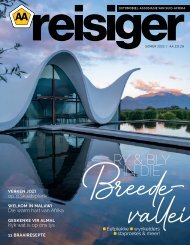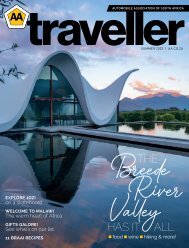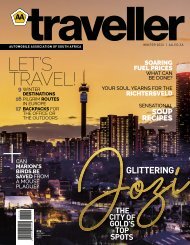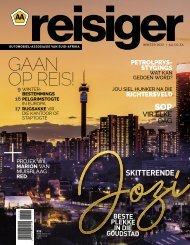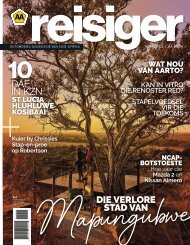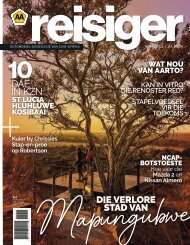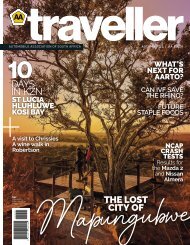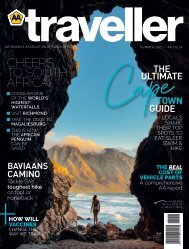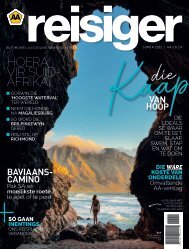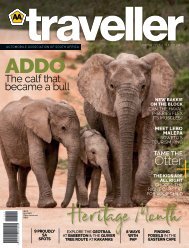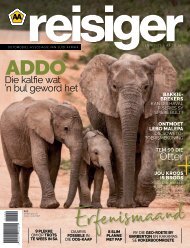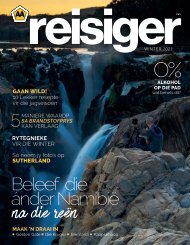Traveller SPRING 2022
The magazine of the Automobile Association of South Africa
The magazine of the Automobile Association of South Africa
Create successful ePaper yourself
Turn your PDF publications into a flip-book with our unique Google optimized e-Paper software.
Weekend getaway<br />
offered time and inspiration to make the move<br />
immediately. “It’s becoming more and more popular –<br />
workations or semigration – people who come here to<br />
work remotely. A good internet connection makes this<br />
possible. There was a woman today who booked a stay<br />
for a whole month.”<br />
Jens talks about the growing property market – “a<br />
good sign in a small town” – but don’t despair if you<br />
can’t pack up your life and settle in the countryside<br />
yet. Philippolis is located both in the middle of<br />
nowhere and somewhere in the middle of South<br />
Africa, which makes it a popular overnight stop for<br />
people travelling between the north and coastal areas.<br />
The N1 used to meander through Philippolis but<br />
was rerouted in the 1970s. This dealt a financial<br />
blow to several small towns, but Jens likes to<br />
focus on the positive. With no large trucks<br />
speeding through, the town has been<br />
able to keep some of its original charm.<br />
The next time you’re on your way<br />
to Cape Town or the Kruger, turn off<br />
the N1 at Trompsburg or Colesberg<br />
and follow the R717 to Philippolis to<br />
experience this tranquil town.<br />
40<br />
WHY PHILIPPOLIS?<br />
A handful of inhabitants like Jens and his partner live<br />
in Philippolis because lockdown offered them the<br />
opportunity to do so, but the pandemic also ushered<br />
in a group of young people who moved out of cities<br />
and now work remotely from here: creative directors,<br />
marketers, and directors and producers in the TV and<br />
music industry.<br />
Juliette Whelpton now lives here because she<br />
followed the tracks of a horse, more specifically, a<br />
white Arabian called Maharajah. During the South<br />
African War, the stallion assisted the British general<br />
and politician John Edward Bernard Seely (Jack Seely)<br />
in the area.<br />
Maharajah is the fourth horse from the South<br />
African War that Juliette has written a book about.<br />
“Die Helde met Hoewe book series is aimed at children<br />
between the ages of nine and 14, but due to the<br />
historic facts, older readers enjoy them as well,”<br />
she says.<br />
Juliette’s research has taken her to various<br />
battlegrounds in our country, from KwaZulu-Natal<br />
to Mpumalanga and the Free State, where, with<br />
the help of horses, she now offers Healing Hooves<br />
wellness workshops.<br />
Juliette also owns the Karoo Artist’s Café and Starry<br />
Night Karoo Cottages in Tobie Muller Street, easily the<br />
prettiest street in town. The writer Karel Schoeman<br />
hit the nail on the head when he once referred to<br />
Philippolis as “the Stellenbosch of the Free State”,<br />
especially with its “heritage green roofs and white<br />
chalk historic building”.<br />
CLOCKWISE<br />
FROM THE<br />
TOP: The Dutch<br />
Reformed<br />
Church in<br />
Voortrekker<br />
Street.<br />
Nicolene<br />
Gibbons with<br />
her linocut art.<br />
Kets and Adele<br />
Underhay.<br />
Brinley<br />
and Erina<br />
Pritchard’s<br />
racing pigeons.<br />
In this street, you’ll find the Nagmaal Huis, with its<br />
typical Karoo-style flat roof, and the Hartjiehortjiehuis<br />
(the name refers to its heart-shaped wooden shutters)<br />
and both are national historical monuments.<br />
The Karoo Artist’s Café is in a large rectangular<br />
building, apparently built as a classroom in the 1880s,<br />
but Juliette has photos that indicate that the café<br />
could have been a weaving room once. In fact, Emily<br />
Hobhouse started the country’s first spin and weave<br />
school here in 1905.<br />
Today it’s the type of space than can easily host<br />
various types of events, from a book reading to a blues<br />
concert or a movie night. Juliette is fond of screening<br />
movies, regularly gets musicians to perform, and locals<br />
come here to sell their goods at the weekly market,<br />
called the Stoepkletsmark.<br />
Kets and Adele Underhay sell their tomato jam here<br />
on Thursdays at 16:00. They live in Rowelsfontein, a<br />
suburb whose huge lawns were irrigated with water<br />
from the fountains, but these irrigation ditches aren’t<br />
used anymore. Their windmill supplies them with<br />
water for the fresh fruit, vegetables, and nuts they<br />
cultivate in greenhouse tunnels. Adele also cultivates<br />
AA <strong>Traveller</strong> | <strong>SPRING</strong> <strong>2022</strong>




